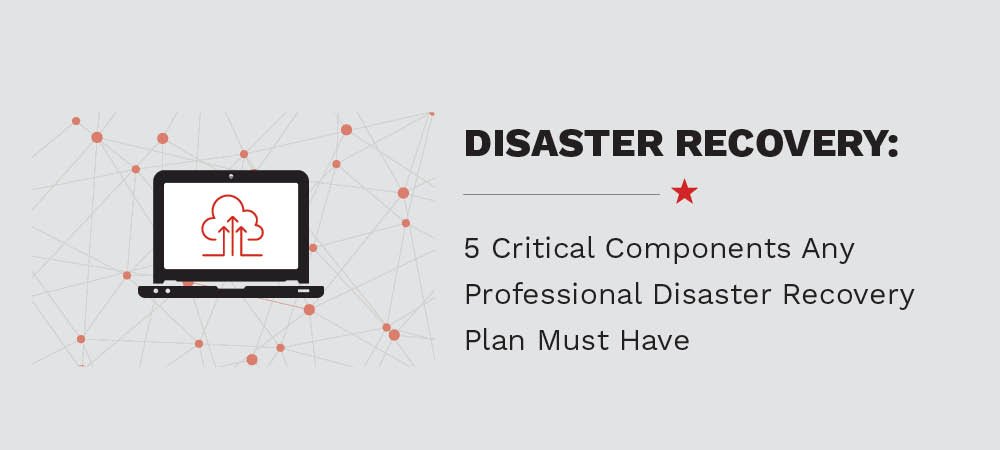
5 Critical Components For Any Professional Disaster Recovery Plan
We hear a whole lot about ransomware and cyber criminals these days. Andromeda helps our clients combat most data breaches with multi-tiered security solutions and employee training. But, every business is still vulnerable to incident. That is why a full proof and dependable Disaster Recovery & Business Continuity plan is an essential. Before you hit the world wide web searching for DR solutions and backup plans, take a look at these 5 critical components any professional disaster recovery plan must have.
Your disaster recovery plan should consider appropriate business continuity variables.
Disasters happen; they come in many shapes and sizes. Server crashes, accidental file deletion, physical disasters such as fire or flood and the increasingly common ransomware or malware infection are all scenarios to consider and plan for.
You must ask two important questions yourself in regards to business continuity:
- How much time can pass between recovery points, ie: how much data can you afford to lose; this is commonly known in Business Continuity as RPO – Recovery Point Objective
- How much time can pass between the disaster and recovery, ie: how much time can you afford to be down; this is commonly known in Business Continuity as RTO – Recovery Time Objective
Ideally, your RPO and RTO are as low as possible.
A good Disaster Recovery Plan will consider these factors and have various options for restoring files, folders or even whole servers. Andromeda's solutions aim for minimalizing data loss and interruption.
Data should be stored both locally and offsite.
Many people have an easy time seeing the value in the offsite backup. Whether that’s tape drives taken offsite daily, external USB drives treated the same, or data sent to the cloud for storage, it carries with it a feeling of great comfort knowing that “if the building burns down” the data is still safe.
What few realize is what we mean when we speak about downtime, for incidents that are not quite as catastrophic as a burning building. In those cases, it can take an unacceptable amount of time to get your hands on that offsite backup or to download an entire server from the cloud.
With a Disaster Recovery Plan option that offers backups both locally and offsite (cloud based), you are able to restore large quantities of files and entire server images quickly. Your onsite device should also have the capability to virtualize as a temporary server in the event your main server crashes.
Find a disaster recovery plan option that provides multiple restore options
When you think about restoring from a disaster, you may believe that so long as you have a version of your data somewhere, you are secure. In reality though, your recovery time objective can be greatly impacted by the different options available to you after a disaster. A disaster recovery plan with multiple options for virtualization, restoration and data access is an absolute must for every business.
You may have heard the term “virtualization” before. Being able to virtualize your server either on a physical device at your location or in the cloud simply means that you have a temporary solution that will keep your business up and running while you resolve whatever issue corrupted your data, server or situation in the first place.
A catastrophic hardware failure can put your business down for hours, sometimes days. Rushing that process up can incur huge costs as well: rush delivery, emergency dispatch, etc. In the event of a hardware failure, a virtual copy of your last backup can be spun up. Once completed, you can resume working swiftly. This quick recovery allows you to deal with hardware replacements, scheduling and budgets in an organized fashion.
A top tier solution will provide you with onsite virtualization and an option to virtualize in the cloud. Cloud virtualization is not as quick and can produce some lag time. Nonetheless, in the event your backups are stolen or disaster strikes your building (fire, flood etc.) - the ability to spin up and virtualize data from the cloud means that your business is not at a standstill.
Find out what type of support a vendor provides for disaster recovery plans.
Your company does not want to struggle to get their files restored. You can’t wait hours and hours to restore a file you accidentally deleted. Don't wait for hours to hear back on the status of a data restore. Your IT partner should understand the solution they are providing and be able to work with you directly. Cut out the intermediary. Ensure your vendor monitors all the warranties, all the software support calls, and all monitoring; ensuring your backups are humming all day every day – as they should be.
Don’t trust just any business continuity or disaster recovery plan solution.
There are literally hundreds of options out there for disaster recovery. A quick Google search will give you pages of results. Comparing them is mind numbing, and if we are being honest . . . who takes the time to do all that? Your first step is to find an IT partner that you trust. Check their references. See if they have case studies to show how a disaster recovery functions with the product. Ask for a demonstration of the product. This is serious stuff and you need to trust the hands maintaining and protecting your data. This is not something you want to wait to think about after the disaster. If you don't have a continuity and recovery plan in place, now is the time.
Keep Your Business Safe, Secure, and Running
We’ll take a proactive approach to your manufacturing IT – and help your business blast off.



